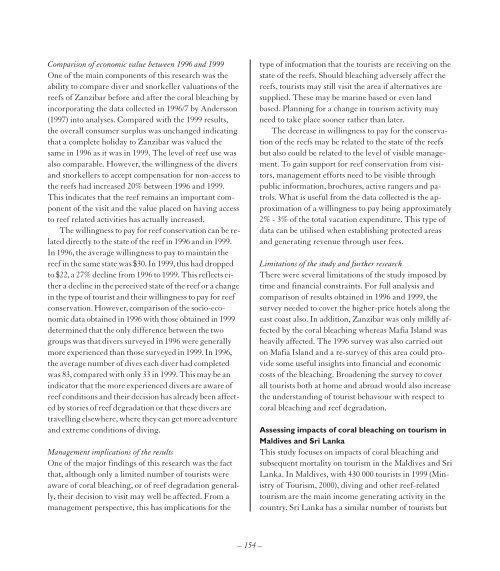You also want an ePaper? Increase the reach of your titles
YUMPU automatically turns print PDFs into web optimized ePapers that Google loves.
Comparison of economic value between 1996 and 1999<br />
One of the main components of this research was the<br />
ability to compare diver and snorkeller valuations of the<br />
reefs of Zanzibar before and after the coral bleaching by<br />
incorporating the data collected in 1996/7 by Andersson<br />
(1997) into analyses. Compared with the 1999 results,<br />
the overall consumer surplus was unchanged indicating<br />
that a complete holiday to Zanzibar was valued the<br />
same in 1996 as it was in 1999. The level of reef use was<br />
also comparable. However, the willingness of the divers<br />
and snorkellers to accept compensation for non-access to<br />
the reefs had increased 20% between 1996 and 1999.<br />
This indicates that the reef remains an important component<br />
of the visit and the value placed on having access<br />
to reef related activities has actually increased.<br />
The willingness to pay for reef conservation can be related<br />
directly to the state of the reef in 1996 and in 1999.<br />
In 1996, the average willingness to pay to maintain the<br />
reef in the same state was $30. In 1999, this had dropped<br />
to $22, a 27% decline from 1996 to 1999. This reflects either<br />
a decline in the perceived state of the reef or a change<br />
in the type of tourist and their willingness to pay for reef<br />
conservation. However, comparison of the socio-economic<br />
data obtained in 1996 with those obtained in 1999<br />
determined that the only difference between the two<br />
groups was that divers surveyed in 1996 were generally<br />
more experienced than those surveyed in 1999. In 1996,<br />
the average number of dives each diver had completed<br />
was 83, compared with only 33 in 1999. This may be an<br />
indicator that the more experienced divers are aware of<br />
reef conditions and their decision has already been affected<br />
by stories of reef degradation or that these divers are<br />
travelling elsewhere, where they can get more adventure<br />
and extreme conditions of diving.<br />
Management implications of the results<br />
One of the major findings of this research was the fact<br />
that, although only a limited number of tourists were<br />
aware of coral bleaching, or of reef degradation generally,<br />
their decision to visit may well be affected. From a<br />
management perspective, this has implications for the<br />
type of information that the tourists are receiving on the<br />
state of the reefs. Should bleaching adversely affect the<br />
reefs, tourists may still visit the area if alternatives are<br />
supplied. These may be marine based or even land<br />
based. Planning for a change in tourism activity may<br />
need to take place sooner rather than later.<br />
The decrease in willingness to pay for the conservation<br />
of the reefs may be related to the state of the reefs<br />
but also could be related to the level of visible management.<br />
To gain support for reef conservation from visitors,<br />
management efforts need to be visible through<br />
public information, brochures, active rangers and patrols.<br />
What is useful from the data collected is the approximation<br />
of a willingness to pay being approximately<br />
2% - 3% of the total vacation expenditure. This type of<br />
data can be utilised when establishing protected areas<br />
and generating revenue through user fees.<br />
Limitations of the study and further research<br />
There were several limitations of the study imposed by<br />
time and financial constraints. For full analysis and<br />
comparison of results obtained in 1996 and 1999, the<br />
survey needed to cover the higher-price hotels along the<br />
east coast also. In addition, Zanzibar was only mildly affected<br />
by the coral bleaching whereas Mafia Island was<br />
heavily affected. The 1996 survey was also carried out<br />
on Mafia Island and a re-survey of this area could provide<br />
some useful insights into financial and economic<br />
costs of the bleaching. Broadening the survey to cover<br />
all tourists both at home and abroad would also increase<br />
the understanding of tourist behaviour with respect to<br />
coral bleaching and reef degradation.<br />
Assessing impacts of coral bleaching on tourism in<br />
Maldives and Sri Lanka<br />
This study focuses on impacts of coral bleaching and<br />
subsequent mortality on tourism in the Maldives and Sri<br />
Lanka. In Maldives, with 430 000 tourists in 1999 (Ministry<br />
of Tourism, <strong>2000</strong>), diving and other reef-related<br />
tourism are the main income generating activity in the<br />
country. Sri Lanka has a similar number of tourists but<br />
– 154 –


















